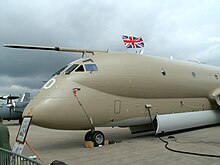Royal Air Force Nimrod crash in Afghanistan

XV230 at the Waddington Airshow, July 2005
|
|
| Accident summary | |
|---|---|
| Date | 2 September 2006 |
| Summary | On board fire following aerial refuelling |
| Site | Chalaghor in the Panjwaye District of Kandahar, Afghanistan |
| Crew | 14 |
| Fatalities | 14 (all) |
| Survivors | 0 |
| Aircraft type | Nimrod MR2 |
| Operator | Royal Air Force |
| Registration | XV230 |
| Nimrod MR1 XV230 cutaway and weapon loadout | |
|
|
On 2 September 2006, a Royal Air Force Hawker Siddeley Nimrod suffered an in-flight fire and subsequently crashed in Kandahar, Afghanistan, killing all fourteen crew members on board. The crash, which occurred during a reconnaissance flight, was the biggest single loss of life suffered by the British military since the Falklands War.
The aircraft involved in the accident was XV230, the first of 38 Nimrod maritime reconnaissance/strike aircraft to enter operational service with the Royal Air Force on 2 October 1969. At a ceremony held at Woodford airfield in Cheshire, the aircraft was handed over by the deputy managing director of Hawker Siddeley Aviation, Sir Harry Broadhurst. Receiving XV230 were the AOC-in Chief of Coastal Command, Air Marshal Sir John Lapsley. At Broadhurst's invitation, Lady Lapsley performed the naming ceremony. Later in the day an RAF crew flew XV230 to its base at RAF St Mawgan, Cornwall, where the Nimrod maritime operational training unit (MOTD) was to be formed.
According to Jane's Information Group, XV230 was one of six Nimrods equipped with an L-3 Wescam MX-15 electro-optical turret in 2003. In June/July 2006 XV230 was given the capability to transmit real-time video imagery from the MX-15 to ground stations and commanders. This was implemented under Project Broadsword.
The aircraft is believed to have suffered a fuel leak during mid-air refuelling while it was monitoring a NATO offensive against Taliban insurgents west of Kandahar. The fuel appears to have leaked into the bomb bay where it caught fire, either as the result of an electrical fault or hot air leaking from a heating pipe.
...
Wikipedia
